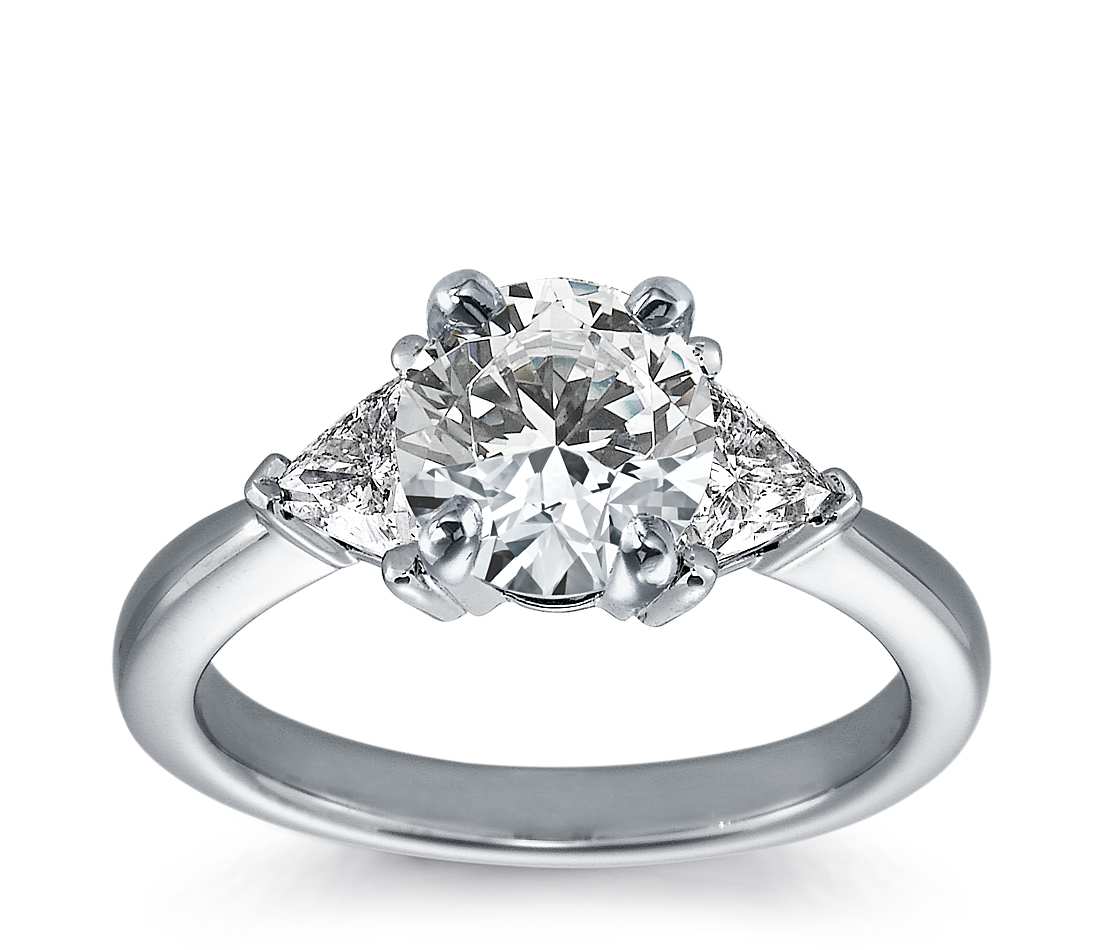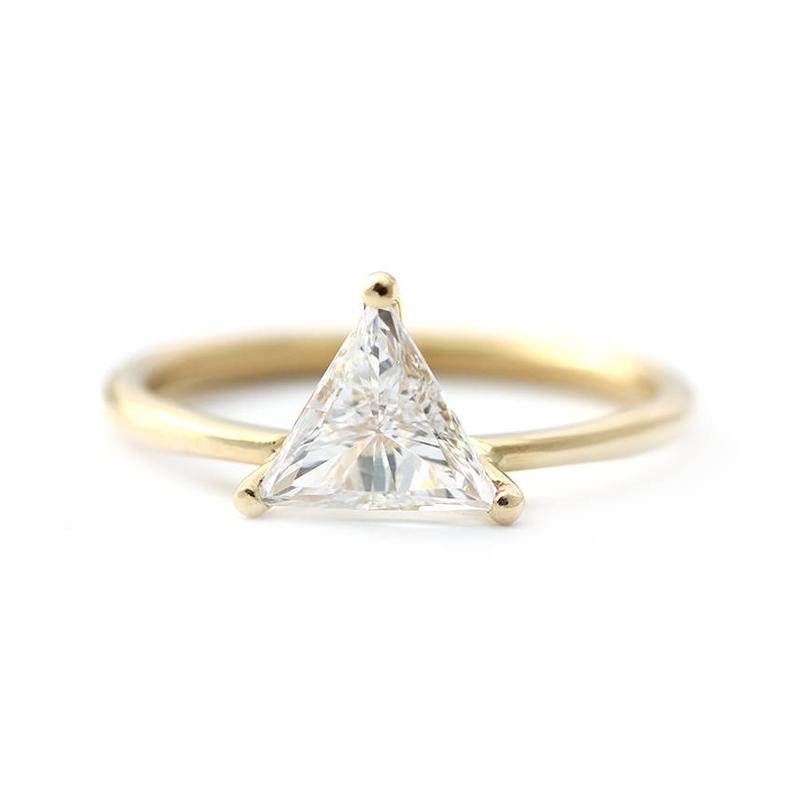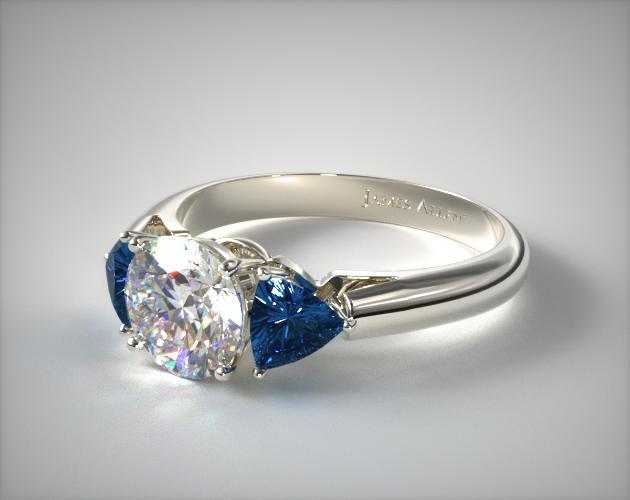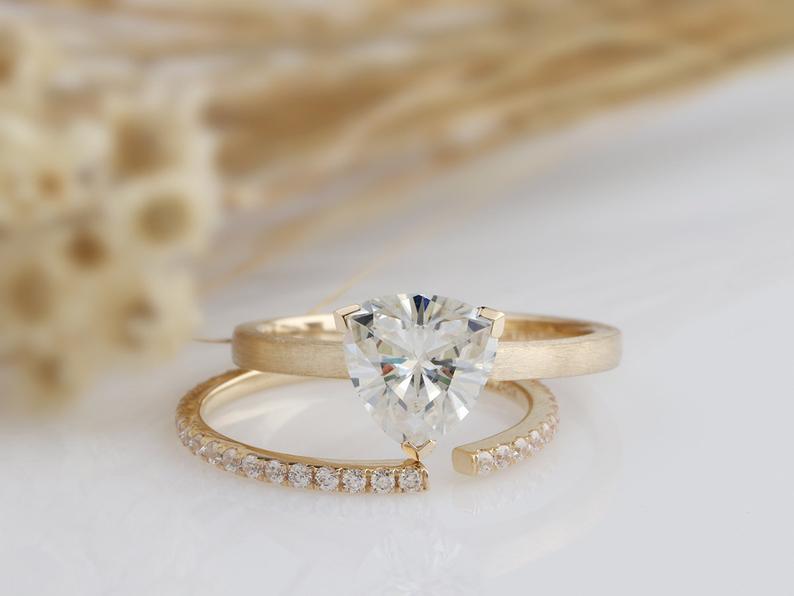
Table of Contents
As Jewelry Shopping Guide editors, we write about things that we love and we think you’ll like too. We often have affiliate partnerships, and may generate some revenue from these links at no cost to you.
The trillion cut is a popular shape for accent stones in beautiful jewelry designs but it can also work as a center stone for someone looking for a different alternative to traditional diamond cuts. It’s symmetry, proportion and unique shape and faceting structure makes the trillion an eye-catching option.
A rarer choice, the trillion diamond is for someone who wants something off the beaten path. If this sounds like you, keep reading as we outline why including a trillion diamond to your jewelry is an excellent idea.
Pros And Cons Of Trillion Cut Diamonds

As such a unique shape, the trillion cut has a lot of distinctive positives and negatives. All of its drawbacks can be worked around, however, so don’t let them stop you.
Pros:
- The trillion cut offers excellent brilliance when it isn’t cut too shallow
- This cut appears to be larger than an equal-sized round or princess cut meaning you can make the most of the diamond’s carat size
- The trillion cut offers a unique alternative to the traditional cuts that most people use for centerpiece diamonds.
Cons:
- The trillion cut is more vulnerable to chipping because of its points. A good protective setting should be used for these stones.
- It can be more difficult to set and requires unique settings that can accommodate the shape.
- The trillion doesn’t tend to work well with some prongs designs. V-prongs are the best for a trillion-cut stone as they wrap the tips of the stone and protect them. Standard prongs can work to an extent, but they won’t fit too well and the stone will be at an increased risk of chipping.
- The trillion cut requires more cleaning and care than other cuts. Because the trillion cut is shallower than round or princess cuts, its light reflection can be dimmed easily by even just a little bit of dirt. This means that you’ll need to clean it more frequently to maintain its good condition.
What Is A Trillion Cut Diamond?
The trillion cut, also called trilliant or trillian, is triangular in shape with all three sides being equal in length.
1- Trillion Cuts as Side Stones

Trillion cuts are typically used as side stones in rings and other jewelry. The cut makes for a great side stone because of its shape – the triangular form allows it to excellently complement the main stones in rings and other jewelry, fitting in perfectly. Just take a look at this engagement ring from Blue Nile and the perfect way in which the two triangular cut side diamonds accent the main round stone. Usually, when a trillion is used in a side stone, it’s cut with 31 facets and contains straight edges.
2- Trillion Cuts as Center Stones

The trillion cut can work well as the centerpiece as well. One of the characteristics of this cut is that it has exceptional brilliance – something that we all want from our diamonds and that’s fantastic for a centerpiece stone. Trillion cuts used as center stones typically contain 50 facets, which allows for more brilliance. The edges tend to be curved or convex.
History Of The Trillion Cut
The trillion cut is often said to have been developed in the 1970s but that’s simply when it was trademarked by the Henry Meyer Diamond Company of New York. In 1962, to be precise, this manufacturer developed the by-now classic cut and named it trillion. Very soon after, all triangular-shaped brilliant-cut diamonds adopted the name.
If we look further back into history, however, we can find a lot of other triangular brilliant cut stones. Amsterdam is generally credited for being the location where trillion cuts originated in the 18th century.
Regardless of where we choose to draw the point for the inception of this cut, the modern Trillion cut its official beginning in 1962 in New York.
How To Cut A Trillion?
The trillion cut is trickier to cut than other diamond cuts and requires a lot of precision. It’s very easy to chip a trillion-cut stone, both during the cutting or polishing phases, and when setting it into a piece of jewelry.
The cutting of each individual stone should be done with the exact idea as to how it’s going to be used in jewelry as the different uses of the trillion cut suggest its exact shape. Trillion cuts are also typically quite shallow compared to other stones but it’s important not to make them too shallow or they will lose a significant portion of their brilliance and fire.
All these possible complications during the cutting process are a part of the reason why the trillion cut was so rarely attempted before the 20th century. Only diamond rough with very specific shapes and parameters could have effectively been turned into a good triangular brilliant cut with the limited technology that cutters used for centuries before the invention of the laser drill.
How To Buy A Trillion Cut Diamond?
The first tip for buying a trillion cut stems from the drawbacks that we’ve listed above – make sure that the setting and jewelry design will match the stone perfectly.
Aside from that, make sure the diamond is well cut and has symmetrical sides and overall proportion. Also, check that the stone isn’t too shallow. It’s normal for trillion cuts to be shallower than round or princess cuts but, as we’ve already mentioned, if too shallowly cut, this will compromise the beauty of the stone.
In addition to that, we’d recommend that you look for trillion cuts with a color quality of H or higher, a clarity of SI or better, and cut parameters that fall in the following ranges:
- Depth: 32% – 48%
- Table 50% – 70%
- Length to width ratio: 1.00 – 1.10
- A good or better polish/symmetry
Of course, you should also always look for eye-clean diamonds regardless of their clarity grade, accompanied by GIA or AGS certifications.
Best Setting For A Trillion Cut Diamond
Because of how easy the trillion cut is to chip, it’s extremely important for its setting to offer excellent protection.
As we mentioned, V-prongs are the best choice for this cut, but as far as the setting is concerned – bezel and protective 3-prong halo settings like this one are usually the best choices.
To Wrap Up…
The trillion cut is a unique, brilliant, and beautiful cut that definitely deserves more attention in our opinion. The dominance of round and princess cuts, as well as that of the cushion, emerald, pear, asscher, oval, and the other more popular cuts, unfortunately, means that the trillion cut is usually relegated to a side stone in most situations. However, if a specific jewelry and setting design can work well with a triangular-shaped brilliant cut diamond, we’d recommend considering a trillion cut.
Looking for a trillion cut diamond? Click here to browse.









